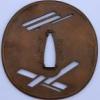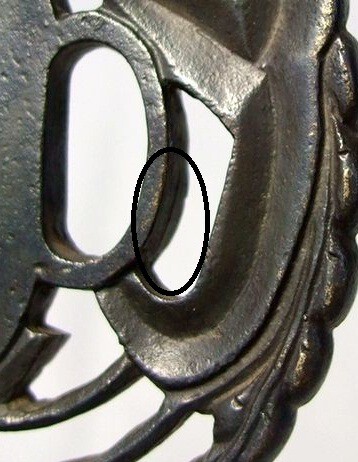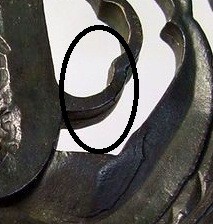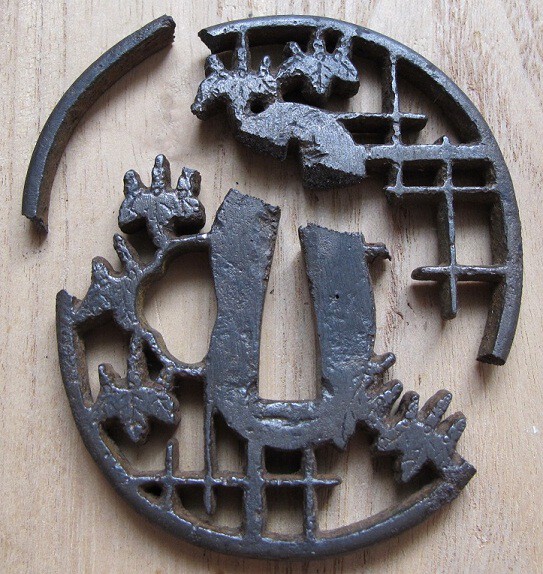-
Posts
827 -
Joined
-
Last visited
-
Days Won
4
Content Type
Profiles
Forums
Events
Store
Downloads
Gallery
Everything posted by Lee Bray
-
Jean, You're correct. I got my info from Hawley, which lists Muramasa 3 as working from 1521-32 and the first two generations as much earlier.
-
Late Muromachi, I say Muramasa 3rd.
-
For many, the beauty of the Japanese sword lies in its graceful curved shape, the pattern of the steel grain and the hamon. These are all vitally important to the functionality of the sword; the curve facilitates cutting, the hada a product of improving the initially poor(prior to forging) steel quality, and the hamon a product of the differential hardening which was needed to create the soft spine for resilience and the hard edge for staying sharp in use. So with that said, what is it you don't believe? As a newbie, I think you're reaching a long way to call anything a true work of art. In any field of interest. Newbies cannot make that call. As a newbie myself, I do not feel educated enough to call any Japanese sword a true work of art. Sure, there are plenty of blades that I like and that I feel are more 'artistic' than other blades, but I'm not qualified enough to make that call.
-
-

Are those Fuchi Kashira real or not?
Lee Bray replied to Drago's topic in Auctions and Online Sales or Sellers
Hi Tobias, I've bought from Candelaria(ebay) before and the deal was flawless. With the Owazamono name common to both sources, I suspect they are one and the same and perfectly legitimate. But, as Grey says, contact them for peace of mind. If you run a search for Nara Toshishige on google(web, not image), you'll find four or five examples of his mei and also one on this forum of a set I own that I posted in the translation section. Here's a papered example from Bushiart.com - http://www.bushiart.com/shop/NI.asp?pag ... &menuName= There seems to be some small variance in all his mei. The set on Owazamono.com/ebay has a wayward Toshi kanji compared to the other examples but the workmanship seems very similar and of good quality. Your money, your call. -
If you're referring to fujisanblack by that link, then yes, he is a genuine seller. It's his auction that has been plagiarised.
-
Could someone please PM me the contact details of John Prough, a New York sword collector? It's in relation to some possible business with a New York auction house. My thanks.
-
Hi Henry. Thanks for your opinion. I tend to share the thought that it is low quality. I think the 'older' call was based on gut feeling rather than anything solid. My own thoughts about it being Meiji were based on the tsuba and the quality of the suriage work done to the sword. In hand, the suriage work last done on the sword seems to be rather rough. It gives the feeling it was done just to fit the nakago into the tsuka and the nakago was not finished cleanly. To me, this indicated cheap work done to sell the sword and recalling the Shinshinto tachi copies, that's where my thoughts went. But the sword itself does not appear to be low quality, hence my curiosity. I get to Japan on the 24th; doing Bob Hughes Kamakura trip if that happens. Not sure that I'll be taking the sword into the DTI itself as I don't fancy carting a sword case around all day. If I do, I'll take it on the 29th. That reminds me...I've heard the DTI has an unofficial 'shinsa' table where you can get opinions but I didn't see it last year. Is this the case?
-
Hi Keith, The tachi will be going to Japan for some hands on opinion. I'm too curious to let it slide. It's the first time I've seen the fibre reinforcing. The saya wood cross section is quite thin and the resultant saya is very light weight. Not sure if it is unusual or possibly a way to date the saya.
-
This is a tachi koshirae I've recently obtained, the blade being here - viewtopic.php?f=1&t=11123 I originally thought it to be Meiji period but a couple of opinions I respect have said it maybe a lot older. The hangers(ashi?) are later, low quality additions but the rest match and are gold washed copper nanako. The tsuba is 4.5mm thick, 85mm tall and 80mm wide. There is a sekigane missing from the upper but the lower seems not to have had one. Around the entire 'seppa dai' perimeter(that meets the inome) there is evidence of cross hatching with traces of gold nunome zogan. Hard to see with the eye but viewable with a loupe. Gold perimeter was around 1mm wide. The iron surface makes me think late Edo, more likely Meiji, but the 'missing' gold made me wonder if the tsuba was older with a later restoration. Considering taking the koshirae and blade to Japan in October for a few opinions. What do you fellas think in the meantime?
-
I've just been given this tachi by my father; it's been his for thirty years, bought in Belfast, Ireland. Nagasa is 28" Mihaba is 30mm, sakihaba is 23mm Kasane is 7mm tapering to 5mm at the kissaki. Nakago has 2 mekugi ana - top is drilled and lower is punched. There is also a partial ana at the nakagojiri which is punched. If this partial ana was the original and single ana, the nagasa would be around 33". In the right light, a chu-suguha/ko-notare hamon can be seen. My thoughts are that the sugata suggests late Kamakura/Nambokucho era. I think the nakago has been altered(shortened) at least twice; the last time being the drilled ana which fits the koshirae I'll post in the Tosugu forum. Despite the poor condition with deep scratches, chips and rust, the thickness through the nakago into the blade suggests it's healthy and not over polished. Also, the bohi termination suggests the boshi will be healthy as it doesn't look as though the kissaki has seen a lot of damage. There are a couple of very thin ware in the mune but otherwise seems to be free of flaws. I considered it maybe a Shinshinto copy but I don't think it is, an opinion later backed up by my mentor. So I was very happy for a few days until I found the deep hagire about 10" from the kissaki... I'll be going to Japan in October(DTI) so I'm considering taking this blade along to show one or two dealers for their opinions and also a couple of the board members here. I understand the registration process and fees involved and I'm happy to deal with that. Am I wasting my time and money? I know it's fatal and won't pass shinsa but seems a shame to let a 'National Treasure' go by... :D Main reason being it is my father's sword and I want to know as much as I can about it.
-

any restrictions shipping a sword to china?
Lee Bray replied to troyadam39's topic in Auctions and Online Sales or Sellers
http://www.swordforum.com/forums/showth ... caution-!!! Ebay seller ships sword to China - sword is confiscated and destroyed at customs. -
Hi Grey. I showed your tsuba to a Chinese friend; he reckons the kanji maybe ancient Chinese but not sure. He says the top kanji might read 'Head' and the kanji at bottom left might read 'Light'.
-

any restrictions shipping a sword to china?
Lee Bray replied to troyadam39's topic in Auctions and Online Sales or Sellers
Have you sent a sword to China as opposed to just an item? I've heard from two different Hong Kong sources, though neither official, that while it's legal to make and export swords, it's illegal to import them into China. -

any restrictions shipping a sword to china?
Lee Bray replied to troyadam39's topic in Auctions and Online Sales or Sellers
Forget about it going missing or not being paid for it, those same things can happen in any country. However, getting a sword into China legally is nigh on impossible, apparently. Hong Kong has no restrictions; China has. A local Chinese friend of mine has looked into the details and says it can't be done. You could potentially send the blade to HK and have your China buyer collect at their own risk if you are intent on the sale. -
Kesho yasurime don't necessarily denote Shinshinto. I thought the same but I think it was Jacques that posted an example some time back and since then, I've seen a couple of examples. Here's a papered Sukenao from 1670's - http://www.aoi-art.com/sword/katana/10494.html In this case, though, I think you're right. The take-no-ko-zori sugata combined with the fairly full boshi and kaeri suggest Shinshinto to me. The nakago ana still seem to have a slight burr around the edge so no old age there. Also, the clear line marking the border between nakago patina and polished steel (sabi-giwa ?). That's something I see on Shinshinto blades but not before. As to school and smith...no idea...
-
My pleasure, chaps, and feel free to use the pic if you want, Brian. Now...anyone got a thickish iron tsuba, preferably sukashi with Kirimon motif for sale?
-
Yes. This tsuba came on a papered sword I bought in HK a few years back. The seller was an old fella that said he bought it in Japan twenty years back. Sword is good but the tsuba was plainly cast with cast marks and cast "sekigane". Whether the guy replaced the tsuba whilst in HK and didn't tell me or the tsuba was made in modern day Japan is only going to be speculation. I had intended to file off the cast marks, give it some proper sekigane and a new patina because it fits the sword and also matches the koshirae theme(Kirimon). I know that's sacrilege but the sword's a keeper and I don't have a tsuba to fit it, so... Anyway...all this stuff about cast tsuba recently, I thought sod it and hit the thing with a hammer... Firmly held in a big vice, it was surprising the lack of effort needed to break it. Broke on the first tap with a 1/2 lb hammer. You can see the grain size is huge. I've seen tighter grain in an Aero chocolate bar. So, yes, it would still be a cast tsuba if someone took the time to do some work on it... but now they're going to have to do some welding to this one. If they can find it in the bin...
-
I'll be diplomatic and say that only by being in that situation could I truthfully answer your question. :D
-
You failed her test, Ford...
-
I tend to agree. I think their use as a wood saw was practical to a degree. It would work as a saw but there were much better saws around for proper use. As Piers says, 'Swiss army knife' style, although they do have their uses.
-
I do not think the thick, saw toothed blade would be very useful at deftly cutting flowers or whittling bamboo. A sharp, plain edge is much better for both applications.
-
This thread has a few examples. viewtopic.php?f=1&t=8186&st=0&sk=t&sd=a&hilit=fishing






